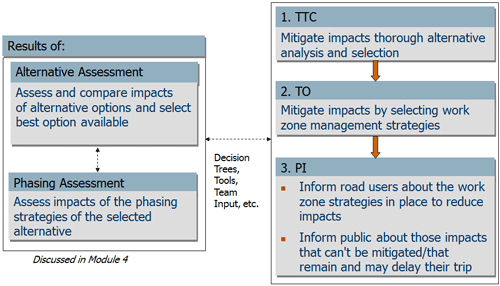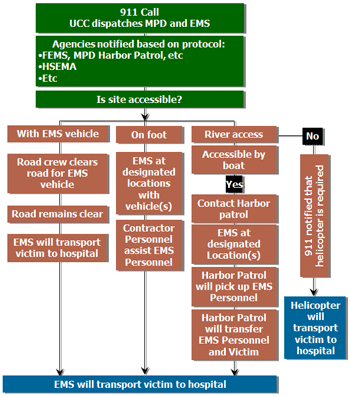Module 5: TMP Strategies
Printable Version [PDF 23.98MB]
PDF files can be viewed with the Acrobat® Reader®.
Contact Information: WorkZoneFeedback@dot.gov
slide 1
Module 5: TMP Strategies
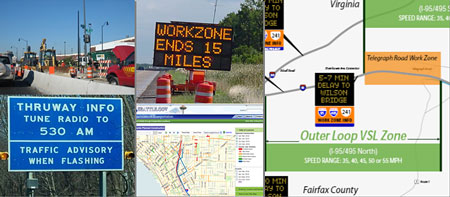

narrator notes
This module discusses TMP strategies that DOTs can use to minimize or mitigate work zone safety and mobility impacts. The module covers TMP strategies and considerations for selecting strategies based on the results of work zone impacts assessment. Impacts assessment was covered in Module 4.
slide 2
About Module 5
- Overview
- Identification of TMP Strategies
- Possible TMP Strategies:
- Temporary Traffic Control Plan (TTCP)
- Transportation Operations (TO)
- Public Information (PI)
- Tools
- Exercise
narrator notes
Module 5 provides an overview, and then discusses identification of TMP strategies; possible TMP strategies; and tools that some Agencies are using to help with selecting appropriate TMP strategies. The module ends with an exercise to help you apply what you have learned.
slide 3
Overview
- Strategies deployed to:
- Improve safety and mobility of work zones
- Reduce work zone impacts on the community/ businesses
- Successful Strategies:
- Enable smooth traffic flow
- Minimize traffic delays
- Maintain or improve safety for road users and workers
- Maintain business and resident access
- Allow for emergency response
- Address needs of other stakeholders
- Support timely completion of the work
narrator notes
TMP strategies are intended to improve the safety and mobility of work zones and reduce the work zone impacts on the community and businesses. Strategies should be selected to enable smooth traffic flow, minimize traffic delays, and maintain or improve safety for road users and workers. Strategies should also maintain access for businesses and residents, allow for emergency response, and address the needs of other stakeholders. TMP strategies should also support the timely completion of the project.
slide 4
Overview
- TMP Strategies grouped in 3 categories:
- Temporary Traffic Control (TTC)
- Transportation Operations (TO)
- Public Information (PI)
- Some Agencies have additional categories
narrator notes
A combination of strategies is necessary to achieve the goals just mentioned.
The Work Zone Safety and Mobility Rule groups TMP strategies into three categories: temporary traffic control, transportation operations, and public information.
Some Agencies have created additional categories of strategies to include in their TMPs. A few States include Incident Management strategies as a separate category in their TMPs for significant projects. A few States have added a new category called Performance Monitoring strategies, that includes any specific observational, logging, and/or recording activities that are required during the project for work zone performance measurement purposes.
slide 5
Overview—Consider Motorist Needs
- Clear and positive guidance through and around work area:
- Traffic Control Devices
- Advanced and Localized signing
- Temporary traffic signals
- Pavement markings
- Flaggers
- Traffic Control Devices
- Adequate time for decision making
- Messages that are easy to understand
- Clear and concise information
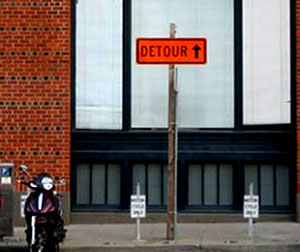
Any guidance here?
narrator notes
In developing a TMP, consider what the needs of motorists are. Motorists must be provided with information in advance to make a safe decision. Road users generally respond to positive guidance. Guidance is often provided using traffic control devices such as advanced and localized signing, temporary traffic signals, and pavement markings; and in some cases by using flaggers. This guidance can also be combined with Intelligent Transportation Systems which provide real-time information about lane closures and travel delays. It is important that the information provided be clear, concise, and accurate. Inaccurate, untimely, or inconsistent messages can lead the public and other stakeholders to lose trust in work zone signage or the Agency's ability to provide reliable information.
slide 6
Overview – Consider Non-Motorist Needs
- Continuous access to bus stops, crosswalks, sidewalks, and other origins and destinations
- Clear and positive guidance
- Safety and security when traveling near work zones
- ADA compliance
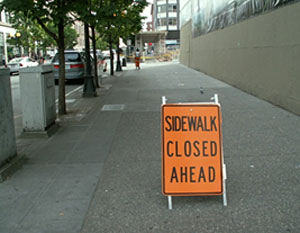
A visually impaired person may not understand that this is a closed sidewalk.
narrator notes
Non-motorist needs are also important, particularly in urban settings where there are pedestrians. Pedestrian accommodations should be at least similar to those existing prior to construction, and may require providing an alternate pedestrian route. Any planned detours must comply with the Americans with Disabilities Act.
slide 7
Overview – Consider Incident Response
- Ensure access to all areas for emergency vehicles:
- Hospitals nearby?
- Trauma centers?
- Plan to provide access within work site:
- Identify alternate routes
- Pre-sign for use during incidents?
- Pre-station tow operators or motorist assist during peak hours
narrator notes
Non-motorist needs are also important, particularly in urban settings where there are pedestrians. Pedestrian accommodations should be at least similar to those existing prior to construction, and may require providing an alternate pedestrian route. Any planned detours must comply with the Americans with Disabilities Act.
slide 8
Overview – Consider Business Access
- Temporary entrances:
- Signing
- Pavement
- Advance notification of phase changes
- Keep owners informed
- Work Schedules:
- Shift changes
- Peak shopping seasons and times
narrator notes
Businesses need to continue to operate during road work, so employees, customers, and those bringing deliveries need to be able to reach businesses affected by a work zone. Access may require a temporary entrance, or signage clearly marking an obscured entrance. Keeping businesses informed and considering work schedules and peak customer periods in developing your TMP can foster good relationships with business stakeholders.
slide 9
Overview – Consider Residential Access
- Keep residents informed as project begins and progresses:
- Maintain access if possible
- Neighborhood association meetings, newsletters, mailings, etc.
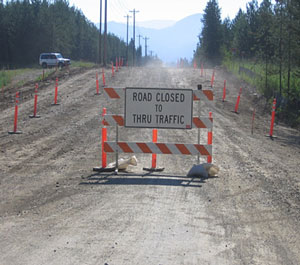
narrator notes
When a project significantly affects the access of residents to their neighborhood, the TMP should include strategies aimed at keeping those residents informed and limiting the duration of the impacts.
slide 10
Identification of TMP Strategies
narrator notes
The results of the impacts assessment should lead to TMP strategy selection.
- The TTC component of the TMP implements the chosen project design strategy. This includes lane widths, taper lengths, speed limits, and the layout of traffic control devices in the traffic control plan to guide road users through or around the work zone.
- The TO component addresses strategies to improve work zone operations, such as communications and detector requirements for a work zone traffic monitoring and incident management system, and estimating traffic diversion patterns and rates to determine potential impacts and appropriately improving operations on alternate routes, such as through signal timing adjustments.
- The PI component estimates the volume of traffic that the project would affect to determine the PI needs, addresses strategies that would be effective in communicating with affected stakeholders, and coordinates with stakeholders to carry out the PI program.
slide 11
Identification of TMP Strategies
- Should be based on:
- Type of work zone
- Traffic conditions
- Anticipated WZ impacts
- Project constraints
- Construction phasing/staging plan
- Conditions in surrounding area (e.g., alternate routes and modes, access)
narrator notes
Selection of TMP strategies is based on various factors, including the type of work zone, such as an urban Interstate paving project; traffic conditions, such as traffic demand and truck volumes; and anticipated work zone impacts, such as delays and queues. Project constraints such as increased right-of-way or construction costs and construction phasing, as well as the conditions in the surrounding area such as available alternate routes and transportation modes should also guide the selection of TMP strategies.
slide 12
Identification of TMP Strategies – Example
| Level of TMP | Types of Conditions | Types of Strategies |
|---|---|---|
| "Blanket" TMP |
|
|
| "Minor" TMP (Majority of TMPs fall into this category) |
|
|
| "Major" TMP (~5% of TMPs are major) |
|
Same as for Minor TMPs plus:
|
narrator notes
California Department of Transportation TMPs are categorized into three levels based on project characteristics and projected delay. For each TMP level, Caltrans provides examples of the types of conditions that would be present for a project to be in that category and possible strategies to use. This table serves as a guide for Caltrans TMP developers.
slide 13
Identification of TMP Strategies
- Analysis to strategy selection:
- Preliminary assessments resulted in 4 options
- Continuous (24/7) Closure
- 72-Hour Weekday Closures
- 55-Hour Weekend Closures
- 10-Hour Night time Closures
- Alternatives assessment (schedule, delay, and Agency costs) resulted in one option
- Continuous (24/7) Closure
- Preliminary assessments resulted in 4 options
narrator notes
In most cases, a preliminary assessment of impacts may result in more than one option. As design progresses, more information may become available on the feasibility of each approach, leading to detailed assessment and selection of the most viable option. In the example shown here, the preliminary assessment resulted in four options. Various measures of effectiveness such as schedule, delay, and Agency costs were considered to arrive at the best option, which was a continuous closure.
slide 14
Identification of TMP Strategies
- Analysis to strategy selection
| Impact | Strategy | |||||
|---|---|---|---|---|---|---|
| Description | Mobility | Safety | Description | TTC | TO | PI |
| Increased queue length beyond threshold | Retime signals | |||||
| Minimize phasing requirements | ||||||
| Implement press advisories to inform the public of expected delays and that they should select alternate routes or other transportation modes | ||||||
narrator notes
In this example, queue length extends beyond the allowable threshold. The DOT chose to implement relatively simple strategies such as signal re-timing, phasing adjustments, and public information to mitigate the particular problem. A matrix as used here can be a useful tool in comparing and selecting the various strategies available.
slide 15
Possible TMP Strategies
| Temporary Traffic Control (TTC) Strategies | Transportation Operations (TO) Strategies | Public Information (PI) Strategies |
|---|---|---|
|
|
|
narrator notes
As noted earlier, TMP strategies fall mainly into three categories. FHWA's TMP Guide subdivides those three categories into several sections based on the purpose of the strategy. These categories and subsections will be discussed on the following slides.
slide 16
Temporary Traffic Control Plan
- Used to facilitate traffic flow safely through and around work zones
- MUTCD is primary source – Part 6 Temporary Traffic Control
- Typical Applications
- 2011 AASHTO Roadside Design Guide, Chapter 9 – Traffic Barriers, Traffic Control Devices, and Other Safety Features for Work Zones
narrator notes
Transportation Agencies use temporary traffic control strategies and traffic control devices to facilitate traffic flow safely through and around work zones. The Manual on Uniform Traffic Control Devices, or MUTCD, and the AASHTO Design Guide, provide national standards, guidance, and other information defining the proper use of traffic control strategies and devices. The MUTCD contains typical applications of traffic control layouts to assist designers.
As shown on the previous slide, there are other types of traffic control and design strategies that can be used to reduce work zone impacts. These other types of strategies include contracting, innovative construction, and project coordination techniques that can accelerate projects or minimize the occurrence of several nearby projects going on at the same time.
slide 17
Temporary Traffic Control Strategies – Examples
- Control strategies:
- Phasing/Staging
- Lane closure
- Narrowed lanes, shoulder use to maintain number of lanes
- Night work, weekend work
- Traffic control devices
- Signing, striping, temporary signals, etc
- Project coordination, contracting, and innovative construction methods
- Incentives/disincentives
narrator notes
The intent of any temporary traffic control strategy is to maximize traffic throughput, especially during peak hours, without compromising safety. A range of traffic control and innovative construction methods are being used to achieve this. Some examples are shown here.
slide 18
Temporary Traffic Control Strategies – Examples
- Temporary Traffic Barrier
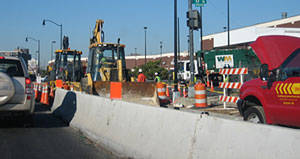
- Advance Work Zone Warning Signs

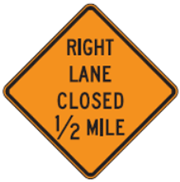
narrator notes
Some additional examples of temporary traffic control strategies are temporary traffic barrier and advance work zone warning signs.
slide 19
Transportation Operation Strategies
- Demand Management
- Transit improvements, carpool incentives, congestion pricing
- Corridor Network Management
- Signal re-timing, reversible lanes, parking restrictions
- Work Zone Safety Management
- Speed management, moveable barrier systems, crash-cushions
- Traffic/Incident Management and Enforcement Strategies
- ITS for traffic monitoring/management, transportation management center (TMC), travel time updates on project delays, Tow/freeway service patrol, increased penalties for work zones, dedicated police enforcement
narrator notes
Transportation operations strategies can mitigate work zone impacts by using improved transportation operations and management of the transportation system in and around the work zones. Strategies include demand management, where the strategies try to influence motorists to consider traveling another way, such as by transit or carpool, to reduce the volume of cars flowing through the work zone. This is particularly useful when the Agency is unable to provide the necessary capacity in a work zone.
Infrastructure or corridor management strategies are where the responsible Agency makes decisions that can affect the road user such as, signal re-timing, parking restrictions, and lane control.
Strategies specifically focused on safety include speed management, barrier installations, and temporary rumble strips.
The last category includes strategies that involve monitoring traffic conditions and making adjustments to traffic operations based on changing conditions. These strategies include more improved detection, verification, response, and clearance of crashes; adequate enforcement of traffic regulations in work zones; and the use of ITS and traffic management centers to monitor and manage traffic.
slide 20
Transportation Operations – Examples
- Ride Sharing Incentive Programs:
- $50/month fare-sharing options offered to commuters to change travel
- One-on-one advice about options
- First 1,000 eligible commuters will be enrolled
- Signal timing improvements
- To keep traffic flowing during construction
narrator notes
The first example is on ride sharing incentive programs. This strategy was successfully implemented on the New York Avenue reconstruction project in Washington, D.C. The District Department of Transportation provided the first 2,000 New York Avenue commuters a $50 per month incentive to use ride-sharing alternatives such as buses, rail transit or organized vanpools. The program also provided one-on-one advice to help commuters determine which alternatives were best for their individual needs.
The second example on signal timing improvement is critical when traffic is still maintained on the main line with a reduced number of lanes compared to normal operating conditions. In such cases more green time on the main line will help keep traffic flowing during construction with less congestion. Signal timing improvements may be needed on detour routes as well, depending on the amount of expected detoured traffic and the current capacity of the detour routes.
slide 21
Transportation Operations – Example
- Dynamic Lane Merge

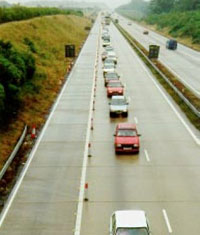 vs.
vs. 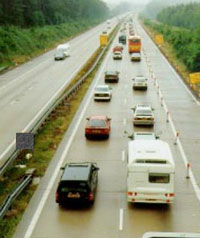
narrator notes
A dynamic lane merge system directs traffic to use both lanes (open and closed lanes) until the designated "merge point" (close to the taper) where traffic from each lane is instructed to take turns merging into the open lane. In congested conditions, this helps reduce queue lengths approaching a lane closure. Shorter queues can improve both safety and mobility.
slide 22
Transportation Operations – Examples
- Real-Time ITS Messages
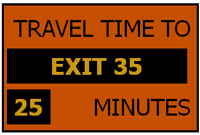
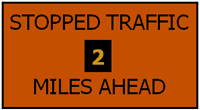

Use simple words and recognizable places.
narrator notes
Informative real time messages help drivers to react positively to changes occurring in traffic ahead and to make informed route choices. Clear and accurate information is the key to maintain road user trust.
slide 23
Transportation Operations – Example
- Variable Speed Limit (VSL) Technology
- Modern systems that change the speed limits in real time
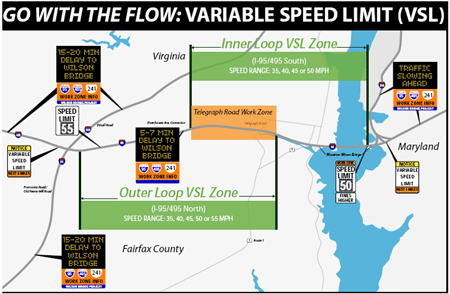
Implemented to assist drivers approaching Beltway/I-95 lane closures associated with Telegraph Road Interchange reconstruction, the final element of the Woodrow Wilson Bridge Project in VA.
narrator notes
Variable speed limit, or VSL, technology is not often used, but on large projects with significant duration, this may be a good tool to control traffic merging. In this example, the system was used successfully on the Woodrow Wilson Bridge Project in the Washington, D.C., area. VSL systems help to maximize traffic flow and improve safety by slowing vehicles down gradually before they reach a lane reduction when there is congestion. This reduces the need for abrupt changes in speed and sudden braking, improving both safety and mobility.
slide 24
Transportation Operations – Examples
- Law Enforcement and Service Patrols
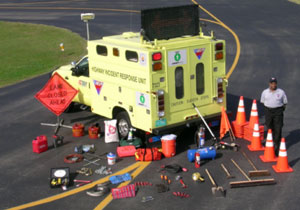
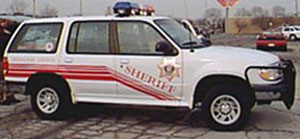
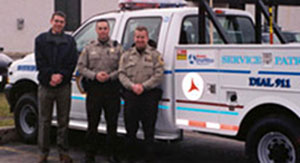
Operator and patrol vehicles displaying standard equipment available for incident response
narrator notes
In many work zone activities, capacity is reduced due to lane closures or even lane shifts or distractions from work activities. It can be helpful to have a service patrol to help remove disabled vehicles and restore capacity quickly. Law enforcement presence can increase the awareness of motorists and help manage traffic speeds.
slide 25
Transportation Operations – Example
Incidence Response Plan for 11th Street Bridges Reconstruction
narrator notes
In developing a TMP, incident response needs to considered. One example is this chart from a bridge project that shows a simplified incident management process from the initial 911 call through to hospital intake. This is important to make the TMP implementation team aware of the process and various roles and responsibilities in case of an accident.
slide 26
Public Information Strategies
- Facilitate public/community awareness and decision making about the work zone and travel options
- Public awareness strategies
- Provide more general information and travel options associated with a work zone
- Motorist information strategies
- Provide the public with specific current and/or real-time information about a work zone
narrator notes
The Public Information component in the TMP has the potential to reduce work zone impacts by providing both general and specific information concerning road projects. These strategies include public awareness strategies and motorist information strategies.
Public awareness strategies educate and reach out to the public, businesses, and the community and provide general information about a road project, the work zone, and travel options.
Motorist information strategies provide more specific information that is current and possibly real-time to road users regarding traffic conditions to expect. Motorist information is generally provided during a trip, after the road user is already in the vehicle.
The key is to engage the public early in the TMP development process, particularly affected communities and businesses, and keep them informed throughout the project.
slide 27
Public Information Strategies
- Public awareness strategies include:
- Newsletters, brochures
- Press releases
- Mass media (earned and/or paid)
- Project Web site
- Public meetings, workshops, community events
- Social Media
narrator notes
Numerous approaches exist to provide the public with general information about a project. These approaches include newsletters and brochures, press releases, the use of mass media advertising, project Web sites, meetings and community events, and social media. Regardless of medium, the key is accurate, timely, and consistent information. Coordination with your Agency's public information office will help to ensure success, particularly for significant projects.
slide 28
Public Information – Example
- Project Web Site
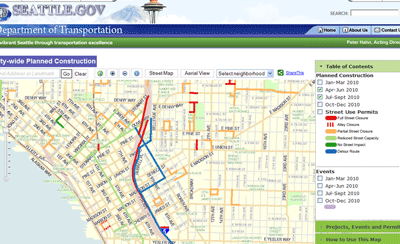
A Construction Coordination Map
The City of Seattle introduced a Web site that consolidates information on planned projects in the City.
narrator notes
This is an example of the project Web site developed for the City of Seattle. The site includes a Construction Coordination Map with details on affected streets and sidewalks, detours, information on the construction projects, bicycle and freight routes, and a link to real-time congestion information.
slide 29
Public Information – Example
Social Media Outlets
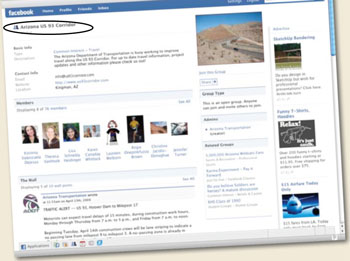
Arizona DOT uses Twitter and Facebook to provide real-time information on work zones.
narrator notes
Social media is emerging as a real time information medium. Many road users of all ages log on to Facebook and Twitter to get regular updates. This can be an effective way to share information for medium to long term projects.
slide 30
Public Information Strategies
- Motorist information strategies include:
- Radio traffic news
- Changeable message signs
- Email alerts
- Highway Advisory Radio (HAR)
- Trucking associations
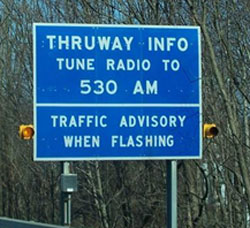
narrator notes
Some motorist information strategies are shown here. Working with traffic reporters to provide near real-time information about lane closures and delays on radio traffic reports can be a good way to reach motorists already enroute in their cars. Changeable message signs and highway advisory radio allow the DOT to provide timely information about traffic conditions such as lane closures, queues, and delays, and can generally be updated by the DOT whenever needed. In areas with significant commercial vehicle traffic, the Agency should consider targeting some information to truckers, such as through a trucking association.
slide 31
Public Information—Examples
- Changeable Message Signs


narrator notes
Informative real time messages help drivers be prepared for changes occurring in traffic ahead. Accurate, clear information is the key to maintain road user trust.
slide 32
Public Information Strategies
- Public information should be:
- Accurate – to maintain credibility
- Timely – to be useful
- Delivered in most suitable ways
- Consistent – to avoid confusion
narrator notes
Public information should be delivered in a way that is most likely to be effective. Often the use of several formats or mediums in combination is most effective for reaching all the relevant audiences. For example, a project Web site might be used for general awareness and pre-trip planning, while changeable message signs near and within the project and radio traffic reports could be used to provide en-route information to drivers. Regardless of the types of mediums used, the information provided needs to be accurate, timely, and consistent.
slide 33
WZ Management Strategies – Example
| Temporary Traffic Control | Transportation Operations | Public Information | ||||||
|---|---|---|---|---|---|---|---|---|
| Strategies | Cost ($) | Strategies | Cost ($) | Strategies | Cost ($) | |||
| Temporary Signs | 300-400 | PCMS with Speed Display | 20,000/ each | Brochures and mailers | 2,000-5,000/ each | |||
| Arrow panels | 5,000-10,000 | Traffic Cameras linked to TMC | 5,000-7,000/ each | Mass Media | 3,000-5,000/ 30 seconds | |||
narrator notes
A spreadsheet or table is good for logging your selection of strategies by type and cost. This allows a designer to review the set of strategies and determine which are the most appropriate ones for that project.
slide 34
Identify Work Zone Management Strategies – Tools used by Various States
- Red Flag Summary (MdSHA)
- Assists in determining any problem areas or issues
- TMP Data Sheets (CALTRANS)
- Used to gather and summarize TMP-related information, including preliminary TMP strategies and costs
- TMP Workbook (TDOT)
- Helps guide and document TMP development
narrator notes
A number of States have developed tools to assist their planners and designers in identifying impacts and selecting strategies to address those impacts.
Maryland's red flag summary assists in determining issues that are present and should be considered during project development.
California uses TMP data sheets to gather and summarize TMP-related information, including preliminary TMP strategies and costs. Caltrans prepares a data sheet for every project and includes a work description and available information about traffic patterns.
Tennessee DOT developed a TMP workbook to aid its staff in developing TMPs. The first part of the Workbook on Project Significance Determination is completed by the planning staff, and then the workbook is passed forward to designers to complete the sections on TMP strategies during project design.
slide 35
Identify Work Zone Management Strategies – Tools used by Various States
- Work Zone Impact Assessment Decision Tree (MnDOT)
- Helps staff make decisions about appropriate level of TMP to develop based on the impacts assessment results
- Developed work zone impact considerations worksheet to use with the decision tree
- Intelligent Work Zone (IWZ) Toolbox (MnDOT)
- Toolbox contains illustrations of IWZ systems that can be deployed
- Provides guidelines for selecting an appropriate system
narrator notes
Minnesota DOT helps staff make decisions regarding the appropriate level of TMP to be developed depending on the work zone impacts through a series of steps. Each district or local road authority is encouraged to develop and implement a general traffic delay-restriction policy for its jurisdiction. Minnesota DOT also developed a work zone impact considerations worksheet to help identify project impacts and potential mitigation strategies.
Minnesota DOT's toolbox provides guidance for selecting an appropriate intelligent work zone system to address work zone traffic issues. The toolbox contains illustrations of systems typically deployed.
slide 36
Identify Work Zone Management Strategies – Tools used by Various States
- TMP Strategy Database (MoDOT)
- Database program that suggests possible TMP strategies based on user inputs about the project
- Helps planners and designers select strategies and develop TMPs in a more systematic way
- Work Zone Design Checklist (MdSHA)
- Helps designers identify traffic control options, work zone impacts, and TMP strategies
narrator notes
Missouri DOT developed a TMP Strategy Database that helps planners and designers select work zone management strategies and develop TMPs in a more systematic way. The database returns possible appropriate work zone management strategies based on user inputs about project-related characteristics. Construction personnel can use the program to find a solution should a concern arise while the work zone is in operation.
Maryland's work zone design checklist helps designers identify traffic control options, work zone impacts, and TMP strategies. It also helps ensure that all appropriate work zone options, impacts, and strategies have been considered.
slide 37
For More Information
FHWA Guides:
- Developing and Implementing Transportation Management Plans for Work Zones
- Work Zone Public Information and Outreach Strategies http://ops.fhwa.dot.gov/wz/resources/final_rule/guidance.htm
Additional State-developed resources:
- http://ops.fhwa.dot.gov/wz/resources/final_rule/tmp_examples/tmp_dev_resources.htm
- http://ops.fhwa.dot.gov/wz/resources/final_rule/impact_asment_ex/other_impacts_ex.htm
narrator notes
FHWA-developed guides and additional State-developed resources are available on the websites listed on this slide.
slide 38
Exercise
narrator notes
Now that you have completed Module 5, this exercise will provide you with an opportunity to apply what you have learned.
slide 39
Exercise Questions
Turn to page 196 in the Participant Workbook for the exercise
- Identify some of the public relations issues that the D/B contractor will need to address during design and construction. What are some TMP strategies that could be used for public outreach?
- Cite some of the operational issues the Contractor will need to address during lane closures. What strategies may be useful to address these operational issues?
To access the Participant Workbook, visit: http://www.ops.fhwa.dot.gov/wz/resources/final_rule/tmp_examples/tmp_training/tmp_workbook.pdf.
narrator notes
Please turn to page 196 in Appendix C in the Participant Workbook. After reading the exercise, please answer the questions on this slide.
slide 40
Exercise Discussion
Turn to page 208 in the Participant Workbook for a discussion of the answers
narrator notes
Once you have completed answering the questions, turn to page 208 in the Participant Workbook for a discussion of the exercise answers.
previous | next